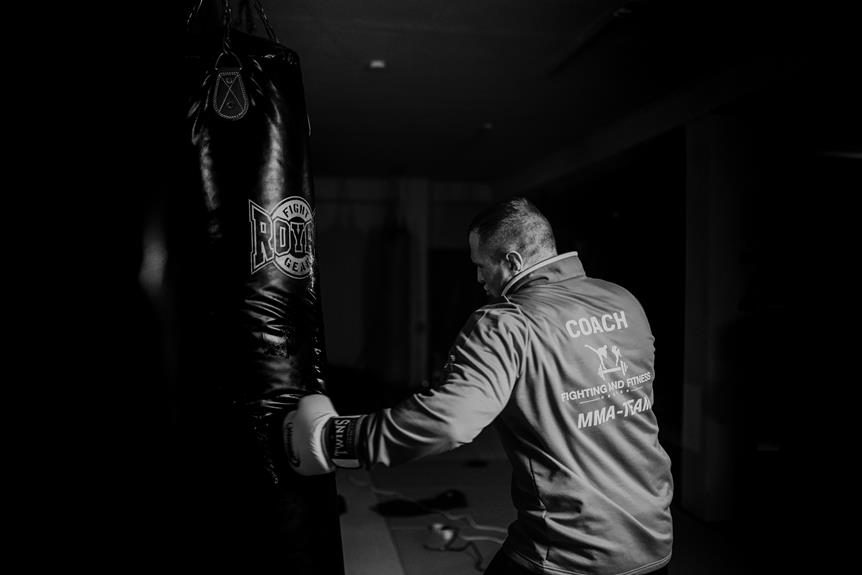In the realm of combat sports, the bolo punch has emerged as a potent technique, capable of commanding attention with its unorthodox style and formidable power.
Like a swift gust of wind, this looping uppercut cuts through opponents' defenses, utilizing a wide circular wind-up and a whipping motion reminiscent of cutting sugarcane with a bolo knife.
This article delves into the origins, effectiveness, and notable practitioners of the bolo punch, offering a comprehensive understanding of its impact within the world of boxing and MMA.
Key Takeaways
- The bolo punch was invented by Ceferino Garcia and Macario Flores and originated from the motion used to cut sugarcane with a bolo knife.
- The bolo punch is an unorthodox looping uppercut with a wide circular wind-up and a whipping motion from hip height.
- The bolo punch is known for its power and effectiveness, making it the most powerful uppercut variation.
- The bolo punch has been popularized by fighters such as Ceferino Garcia, Kid Gavilan, Pedro Carrasco, and Sugar Ray Leonard.
Origins of the Bolo Punch
The origins of the bolo punch can be traced back to Ceferino Garcia and Macario Flores, who are credited with inventing this technique in boxing and MMA.
However, the roots of the bolo punch can be found even earlier, in the streets of the Philippines, where it was used by Filipino gangs in street fights.
The bolo punch draws its inspiration from the motion used to cut sugarcane with a bolo knife, a common tool in the Philippines. This technique was then integrated into panantukan, a style of Filipino boxing intended for street fighting.
Over time, the bolo punch gained cultural significance and became a part of the Filipino martial arts tradition.
Its evolution continued when Sugar Ray Leonard popularized the bolo punch in Western boxing, showcasing its power and effectiveness to a wider audience.
History of the Bolo Punch
The evolution of the bolo punch can be traced back to its integration into panantukan, a style of Filipino boxing intended for street fighting. This unique punching technique holds significant cultural significance within the world of combat sports.
Here is a brief history of the bolo punch:
- Origin in Filipino street fights: Even before its formalization, the bolo punch was utilized by Filipino gangs in their street fights. It drew inspiration from the motion of cutting sugarcane with a bolo knife.
- Integration into panantukan: The bolo punch found its place in panantukan, a Filipino boxing style developed for self-defense in street altercations. Its effectiveness and power were recognized within this style.
- Popularization in Western boxing: Sugar Ray Leonard, a legendary boxer, played a pivotal role in bringing the bolo punch to the Western boxing scene. His skillful execution and success with this technique showcased its potential and influenced other fighters to adopt it.
The history of the bolo punch demonstrates its rich cultural heritage and its impact on combat sports.
Technique and Execution
The technique and execution of the bolo punch involve a wide circular wind-up and a whipping motion, originating from the motion used to cut sugarcane with a bolo knife. This unorthodox looping uppercut requires a specific set of movements to be executed correctly. To throw a bolo punch, one must rotate the rear hand clockwise from 12 to 5, while keeping the arm and elbow close to the body. Simultaneously, the fighter should pivot on the rear leg for added power. It is important to keep the lead hand high for blocking and to follow through with the punch for maximum impact.
There are variations of the bolo punch, such as the double bolo punch, which involves throwing two consecutive bolo punches in quick succession. Another variation is the bolo hook, where the punch is thrown in a horizontal arc, targeting the opponent's body or head.
Common mistakes in executing the bolo punch include telegraphing the punch by winding up too early or too noticeably, leaving the chin exposed, and neglecting to pivot on the rear leg for added power. It is also important to maintain proper balance and footwork throughout the entire motion.
Mastering the technique and execution of the bolo punch requires practice, precision, and attention to detail. By understanding the mechanics and avoiding common mistakes, fighters can effectively incorporate this powerful and unique punch into their arsenal.
Throwing a Bolo Punch
To execute a bolo punch in boxing or MMA, a fighter must master the proper technique and timing. Here are some tips for improving bolo punch technique:
- Maintain proper form: Keep the arm and elbow close to the body during the wind-up and delivery of the punch. This ensures maximum power and accuracy.
- Generate power from the hips: Use a whipping motion by rotating the rear hand from 12 to 5, while pivoting on the rear leg. This generates power from the hips and adds force to the punch.
- Follow through with the punch: The follow-through is crucial for maximum power and impact. Extend the arm fully and aim to hit the target with the knuckles of the middle and index fingers.
Common mistakes while throwing a bolo punch include telegraphing the punch, neglecting defense, and not fully committing to the punch. By practicing these tips and avoiding common mistakes, fighters can improve their bolo punch technique and increase their effectiveness in the ring or cage.
Effectiveness of the Bolo Punch
The effectiveness of the bolo punch in boxing and MMA can be attributed to its unique technique and powerful impact. The bolo punch is known for its ability to generate significant power and cause damage to opponents. Its wide circular wind-up and whipping motion create a devastating uppercut that can catch opponents off guard.
One advantage of the bolo punch is its ability to be used as a counter against onrushing opponents and takedowns. Additionally, the wind-up of the bolo punch can serve as a distraction, allowing fighters to land quick jabs or hooks.
However, there are also disadvantages to the bolo punch. Its wide swinging motion leaves fighters vulnerable to counters, and its telegraphed nature makes it easier for opponents to anticipate and defend against.
Strategies for countering the bolo punch include staying defensively aware, utilizing footwork to create angles, and countering with fast and accurate strikes.
Usage of the Bolo Punch
Popularized by fighters such as Ceferino Garcia and Sugar Ray Leonard, the bolo punch has found widespread usage in both boxing and MMA. Its unique looping motion and devastating power make it a valuable weapon in a fighter's arsenal.
Here are different variations of the bolo punch:
- Classic Bolo Punch: This involves a wide circular wind-up and a whipping motion, creating a powerful uppercut trajectory.
- Lead Hand Bolo Punch: Instead of the rear hand, the lead hand is used to throw the bolo punch, surprising opponents who may not expect the attack from that angle.
- Double Bolo Punch: This is a combination of two consecutive bolo punches, catching opponents off guard and increasing the chances of landing a solid hit.
As with any technique, there are defensive strategies against the bolo punch that fighters should employ:
- Head Movement: By incorporating head movement and bobbing and weaving, fighters can make it difficult for their opponents to land bolo punches.
- Counter Punching: Timing and precision are crucial when countering a bolo punch. Fighters can exploit the wide wind-up by throwing quick counters to catch their opponents off balance.
- Clinching: Clinching can neutralize the bolo punch by closing the distance and preventing the opponent from fully extending the punch.
Understanding the different variations of the bolo punch and implementing effective defensive strategies can give fighters a competitive edge in both boxing and MMA.
Famous Fighters and the Bolo Punch
Renowned fighters have showcased the devastating power and versatility of the bolo punch, leaving a lasting impact on boxing and MMA matches.
Among the famous fighters who have mastered this technique is Ceferino Garcia, one of the pioneers of the bolo punch. Garcia's exceptional skills with the bolo punch earned him multiple world titles and solidified his place in boxing history.
Another fighter who popularized the bolo punch is Sugar Ray Leonard, who utilized it to great effect during his career. Leonard's speed and precision with the bolo punch made him a formidable opponent and contributed to his numerous victories.
The impact of the bolo punch in boxing and MMA matches cannot be underestimated, as it has proven to be a formidable weapon in the hands of skilled fighters. Its ability to generate power and catch opponents off guard makes it a valuable tool in the arsenal of any fighter.
Comparison With the Uppercut
When comparing the bolo punch to the uppercut, one can observe key differences in their execution and effectiveness. Here are some pros and cons of each technique, as well as some training techniques to consider:
Pros and Cons of the Bolo Punch:
- Pros:
- The bolo punch is known for its power and effectiveness, making it a devastating strike.
- The circular wind-up motion can be used as a distraction, allowing for quick jabs or hooks.
- It is effective against opponents who frequently bob and weave.
- Cons:
- The wind-up of the bolo punch leaves the fighter vulnerable to counterattacks.
- It requires proper timing and technique to execute effectively.
- The wide circular motion may telegraph the punch, allowing opponents to anticipate and defend against it.
Training Techniques for the Bolo Punch:
- Focus on building core strength and rotational power to generate maximum force.
- Practice the proper footwork and hip rotation to generate power and momentum.
- Incorporate shadowboxing, heavy bag work, and sparring to develop the timing and accuracy needed for the bolo punch.
Pros and Cons of the Uppercut:
- Pros:
- The uppercut is quicker and works well in combinations and as a counterpunch.
- It can be effective in close-range situations, targeting the opponent's chin or body.
- The vertical trajectory of the punch allows for better accuracy and precision.
- Cons:
- The uppercut may lack the power of the bolo punch, making it less effective in delivering knockout blows.
- It requires good timing and distance management to land effectively.
- It may leave the fighter vulnerable to counterattacks if not executed properly.
Training Techniques for the Uppercut:
- Focus on developing upper body and arm strength to generate power.
- Practice proper body mechanics, including bending at the knees and transferring weight from the legs to the upper body.
- Incorporate bag work, pad drills, and sparring to improve timing, accuracy, and the ability to throw the uppercut in combination with other punches.
Frequently Asked Questions
How Does the Bolo Punch Compare to Other Punches in Terms of Speed and Power?
The bolo punch is renowned for its exceptional power and effectiveness. While it may not match the speed of other punches, its wide circular wind-up and whipping motion generate significant power, making it a formidable weapon in the ring.
Are There Any Specific Training Drills or Exercises to Improve the Execution of the Bolo Punch?
Training drills and exercise techniques can enhance the execution of the bolo punch. By focusing on hip rotation, arm control, and follow-through, fighters can improve their power, accuracy, and timing in delivering this devastating technique.
Can the Bolo Punch Be Used Effectively in MMA or Is It Primarily a Boxing Technique?
The bolo punch can be effectively used in MMA, as it offers power and versatility. Its circular wind-up motion can be used as a distraction, and its effectiveness against bobbing and weaving opponents makes it a valuable technique in MMA.
Are There Any Risks or Disadvantages Associated With Throwing a Bolo Punch?
When utilizing the bolo punch, fighters should be aware of potential risks and disadvantages. These include leaving themselves open to counterattacks, compromising their defensive posture, and the possibility of telegraphing their intentions to their opponents.
Are There Any Variations or Modifications of the Bolo Punch That Fighters Have Developed Over Time?
There have been various variations and modifications of the bolo punch developed by fighters over time. These include variations in the wind-up motion, angles of attack, and target areas, allowing for greater versatility and adaptability in different situations.
Conclusion
In conclusion, the bolo punch has a rich history rooted in Filipino street-fighting techniques. Its wide circular wind-up and whipping motion make it a formidable strike in boxing and MMA. The bolo punch is effective in countering onrushing opponents, capitalizing on bobbing and weaving, and serving as a distraction for quick jabs or hooks.
Notable fighters, such as Sugar Ray Leonard, have popularized this unorthodox technique in Western boxing. The bolo punch remains a powerful and strategic weapon in the world of combat sports.
As the adage goes, 'Precision and power, the bolo punch strikes in its hour.'
- 15 Best Martial Arts Weapons (Fighting & Training) - October 14, 2024
- Is Fencing a Martial Art? (Yes, 4 Reasons Why) - October 14, 2024
- 7 Best Martial Arts for Self-defense Ranked (Highly Effective) - October 14, 2024










